 W
WThe ALWAC III-E was an early commercial vacuum tube computer employing a rotating magnetic drum main storage unit, operational in 1955. It weighed about 2,200 pounds.
 W
WThe Bendix G-15 is a computer introduced in 1956 by the Bendix Corporation, Computer Division, Los Angeles, California. It is about 5 by 3 by 3 feet and weighs about 966 pounds (438 kg). The G-15 has a drum memory of 2,160 29-bit words, along with 20 words used for special purposes and rapid-access storage. The base system, without peripherals, cost $49,500. A working model cost around $60,000. It could also be rented for $1,485 per month. It was meant for scientific and industrial markets. The series was gradually discontinued when Control Data Corporation took over the Bendix computer division in 1963.
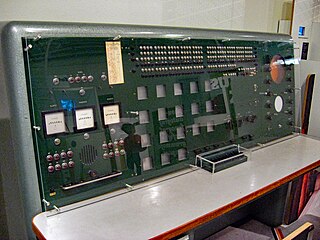 W
WBESK was Sweden's first electronic computer, using vacuum tubes instead of relays. It was developed by Matematikmaskinnämnden and for a short time it was the fastest computer in the world. The computer was completed in 1953 and in use until 1966. The technology behind BESK was later continued with the transistorized FACIT EDB and FACIT EDB-3 machines, both software compatible with BESK. Non-compatible machines highly inspired by BESK were SMIL made for the University of Lund, SAABs räkneautomat SARA, "SAAB's calculating machine", and DASK made in Denmark.
 W
WThe RCA BIZMAC was a vacuum tube computer manufactured by RCA from 1956 to 1962. Although RCA was noted for their pioneering work in transistors, RCA decided to build a vacuum tube computer instead of a transistorized computer. It was the largest vacuum tube computer of its time in 1956, occupying 1,900 m2 (20,000 sq ft) of floor space with up to 30,000 tubes, 70,000 diodes, and 35,000 magnetic cores. It weighed about 12,000 kg (26,500 lb).
 W
WThe DASK was the first computer in Denmark. It was commissioned in 1955, designed and constructed by Regnecentralen, and began operation in September 1957. DASK is an acronym for Dansk Aritmetisk Sekvens Kalkulator or Danish Arithmetic Sequence Calculator. Regnecentralen almost didn't allow the name, as the word dask means "slap" in Danish. In the end however, it was named so as it fit the pattern of the name BESK, the Swedish computer which provided the initial architecture for DASK.
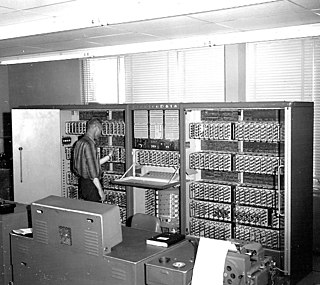 W
WThe Datatron is an obsolete family of decimal vacuum tube computers developed by ElectroData Corporation and first shipped in 1954. The Datatron was later marketed by Burroughs Corporation after Burroughs acquired ElectroData in 1956. The Burroughs models of this machine were still in use into the 1960s.
 W
WEDVAC was one of the earliest electronic computers. Unlike its predecessor the ENIAC, it was binary rather than decimal, and was designed to be a stored-program computer.
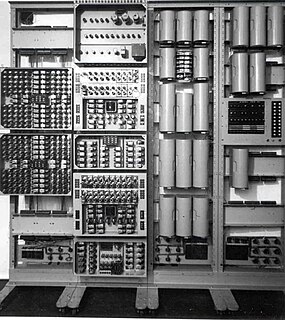 W
WThe Harwell computer, later known as the Wolverhampton Instrument for Teaching Computing from Harwell (WITCH), or the Harwell Dekatron Computer, is an early British relay-based computer of the 1950s. From 2009 to 2012, it was restored at the National Museum of Computing. In 2013, for the second time, the Guinness Book of World Records recognised it as the world's oldest working digital computer, following its restoration. It previously held the title for several years until it was decommissioned in 1973. The museum uses the computer's visual, dekatron-based memory to teach schoolchildren about computers.
 W
WThe IBM 650 Magnetic Drum Data-Processing Machine is an early digital computer produced by IBM in the mid-1950s. The first one was installed in late 1954 and it was the most-popular computer for the next five years. It was announced in 1953 and in 1956 enhanced as the IBM 650 RAMAC with the addition of up to four disk storage units. Almost 2,000 systems were produced, the last in 1962. Support for the 650 and its component units was withdrawn in 1969.
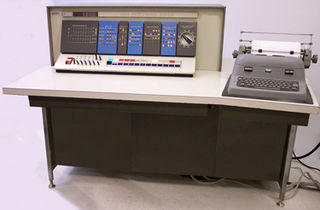 W
WThe IBM 1620 was announced by IBM on October 21, 1959, and marketed as an inexpensive "scientific computer". After a total production of about two thousand machines, it was withdrawn on November 19, 1970. Modified versions of the 1620 were used as the CPU of the IBM 1710 and IBM 1720 Industrial Process Control Systems.
 W
WMailüfterl is a nickname for the Austrian Binär dezimaler Volltransistor-Rechenautomat, an early transistorized computer. Other early transistorized computers included TRADIC, Harwell CADET and TX-0.
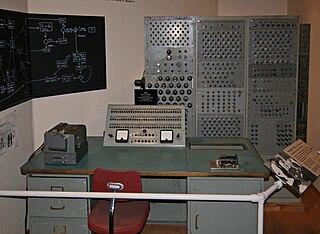 W
WNUSSE was the first Norwegian electronic computer.
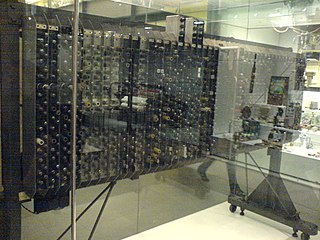 W
WThe Pilot ACE was one of the first computers built in the United Kingdom. It was built at the National Physical Laboratory (NPL) in the early 1950s. It was also one of the earliest stored-program computers, joining other UK designs like the Manchester Mark 1 and EDSAC of the same era. One of the earliest general-purpose computers, it was designed by Alan Turing, who left NPL before the construction was completed.
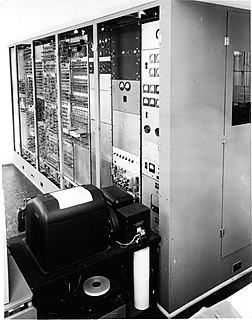 W
WSEAC was a first-generation electronic computer, built in 1950 by the U.S. National Bureau of Standards (NBS) and was initially called the National Bureau of Standards Interim Computer, because it was a small-scale computer designed to be built quickly and put into operation while the NBS waited for more powerful computers to be completed. The team that developed SEAC was organized by Samuel N. Alexander. SEAC was demonstrated in April 1950 and was dedicated on June 1950; it is claimed to be the first fully operational stored-program electronic computer in the US.
 W
WThe Semi-Automatic Ground Environment (SAGE) was a system of large computers and associated networking equipment that coordinated data from many radar sites and processed it to produce a single unified image of the airspace over a wide area. SAGE directed and controlled the NORAD response to a Soviet air attack, operating in this role from the late 1950s into the 1980s. Its enormous computers and huge displays remain a part of cold war lore, and a common prop in movies such as Dr. Strangelove and Colossus.
 W
WSimon was a relay-based computer, described by Edmund Berkeley in a series of thirteen construction articles in Radio-Electronics magazine, from October 1950. Intended for the educational purpose of demonstrating the concept of digital computer, it could not be used for any significant practical computation since it had only two bits of memory. In 1950, it sold for US$600. Some have described it as the "first personal computer", although its extremely limited capacity and its unsuitability for use for any purpose other than as an educational demonstration make that classification questionable.
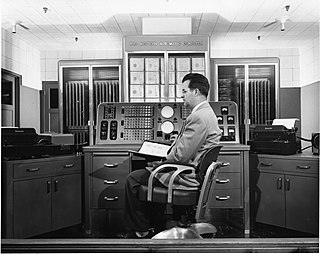 W
WThe SWAC was an early electronic digital computer built in 1950 by the U.S. National Bureau of Standards (NBS) in Los Angeles, California. It was designed by Harry Huskey.
 W
WWEIZAC was the first computer in Israel, and one of the first large-scale, stored-program, electronic computers in the world.
 W
WWhirlwind I was a Cold War-era vacuum tube computer developed by the MIT Servomechanisms Laboratory for the U.S. Navy. It was among the first digital electronic computers that operated in real-time for output, and the first that was not simply an electronic replacement of older mechanical systems.
 W
WThe Z11 was a computer, the first serially produced machine of the Zuse KG.
 W
WThe Z22 was the seventh computer model Konrad Zuse developed. One of the early commercial computers, the Z22's design was finished about 1955. The major version jump from Z11 to Z22 was due to the use of vacuum tubes, as opposed to the electromechanical systems used in earlier models. The first machines built were shipped to Berlin and Aachen.